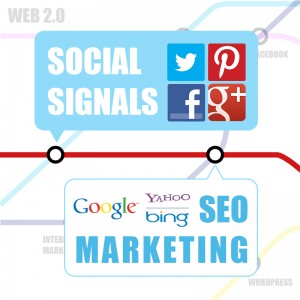The Top Ways in Which Social Signals Affect SEO Marketing
Social signals provide a lot of information about a website’s marketing success but SEO experts believe that these are starting to play an increasingly important role in the realm of satisfactory search engine positioning.
Old-school search engine marketing is no longer delivering the effects that it was once capable of producing in the past. The appearance of Google+ on the social networking scene has made the situation even more confusing. Do you know how to measure social signals and do you have an idea about the manner in which they affect SEO marketing?
Social Signals: The Basics
Social signals are used to measure engagement and the manner in which a website’s social media marketing strategy is evolving. These reveal important information about involvement and acceptance of the campaign in various social networks.
The social signals you need to be looking for include:
– The number of times a page is shared on Facebook.
– The number of times a page is liked on Facebook.
– +1 received in Google+.
– Comments written about content shared in different social networks.
– The number of follows and retweets in Twitter.
– The number of times a specific page is mentioned in the posts of a social network member.
Clearly, social signals have a lot of marketing value and they provide some feedback about the manner in which people are perceiving content or a specific campaign. Social signals, however, are much more than that. It is very important to establish the influence that social signals are having over a search engine marketing campaign.
Google+ and the SEO Landscape
Google introduced a number of major changes to its algorithm lately. These modifications killed traditional SEO and deteriorated the impeccable search engine positioning of various websites.
Google Panda and Google Penguin started the process. The appearance of Google’s social network changed the situation even further. Since the launch of Google+, it was clear that the rules of SEO will never be the same.
Google is working on the provision of personalized search results. Google +1s are part of this change. If a person in your Google+ network has given a +1 to a specific page, you are more likely to see it in the results for a particular keyword. +1s come in the form of recommendations about the quality of pages, which has ultimately become an important part of search engine marketing.
This characteristic has made many SEO experts believe that the social signal is the factor that has come to replace the backlink in terms of SEO.
The Role of Other Social Networks
Google confirmed that a specific social signal set is used to determine aspects of a website’s search engine positioning. The official statement claimed that PageRank and social authority are two independent elements that have nothing to do with each other.
The official release comes to indicate that social signals are still far from the most determining factor in terms of SEO marketing. Still, it is nothing but logical to conclude that the appearance of Google+ social network is going to influence the search engine optimization scene.
Additionally, a social media marketing campaign is determining for the success of an online project in today’s web-driven world. Most marketing experts and webmasters are putting the effort into it, which means that social engagement is engaged because of one reason or another.
Still confused about social signals and search engine optimization? Highly specific information on the topic is missing but you will be doing yourself a favor by encouraging social network sharing. It can drive more traffic to your website and the strategy will ultimately affect your popularity and authority. These two advantages deserve some effort.
Popular posts:
- Social Signals Factors and Your Ranking Success
- Social Signals Are Taking Over Backlinking in SEO, Experts Speculated
- 6 Reasons Social Signals are the Secret to Search Success
- Top Ten Reasons Why Businesses Should Incorporate Social Signals in their Marketing Strategy
- Social Signals Explained – What are they and how are they important?







